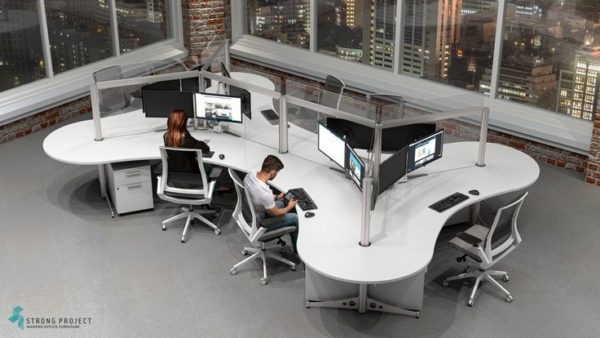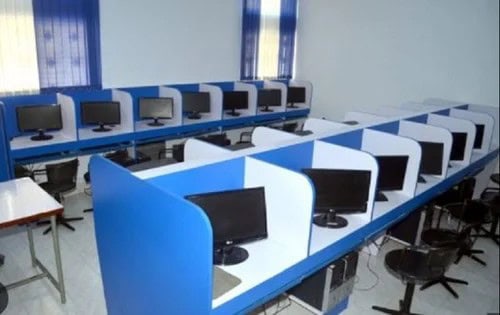In the modern workplace, the design and layout of office spaces play a crucial role in employee productivity, collaboration, and satisfaction. As companies look for ways to optimize their work environments, the debate between dogbone cubicles and traditional workstations has become increasingly relevant. Each option has its unique advantages and considerations, making it essential for businesses to evaluate which is best suited for their needs. This article will explore the key differences between dogbone cubicles and traditional workstations, helping you make an informed decision for your organization.
Understanding Dogbone Cubicles

Dogbone cubicles are designed with two workstations positioned back-to-back, separated by a shared panel. This configuration resembles a dog bone from above and is intended to facilitate both collaboration and individual work. The layout encourages communication among team members while maintaining a degree of privacy. Here are some features of dogbone cubicles:
- Space Efficiency: Dogbone cubicles maximize office space by accommodating multiple employees within a compact layout.
- Collaboration-Friendly: The design fosters teamwork and communication, making it easy for employees to engage with one another.
- Modular Design: Dogbone cubicles can be easily reconfigured to adapt to changing team dynamics or office layouts.
Boosting Office Productivity: Tips and Strategies for Success
Understanding Traditional Workstations

Traditional workstations typically consist of individual desks or cubicles that provide employees with personal space. These workstations can vary in size and configuration, ranging from closed-off cubicles to open-plan desks. Key characteristics of traditional workstations include:
- Individual Privacy: Employees have more personal space, which can enhance focus and concentration on tasks.
- Customization Options: Traditional workstations can be tailored to individual preferences, allowing employees to personalize their environment.
- Potential Isolation: While offering privacy, traditional workstations can sometimes create silos, leading to reduced collaboration among team members.
Comparing the Two Options
1. Collaboration vs. Privacy
One of the most significant differences between dogbone cubicles and traditional workstations is the balance of collaboration and privacy they offer. Dogbone cubicles encourage interaction and teamwork, making them ideal for businesses that prioritize collaboration and open communication. However, they also provide enough separation for employees to focus on their tasks without constant distractions.
On the other hand, traditional workstations tend to prioritize privacy, allowing employees to work without interruptions. This can be advantageous for tasks requiring deep concentration but may hinder spontaneous collaboration and idea-sharing among team members.
2. Space Optimization
In terms of space efficiency, dogbone cubicles often have the upper hand. Their design allows companies to fit more employees into a smaller area, making them suitable for organizations with limited square footage. This can be particularly valuable in urban settings where real estate costs are high.
Conversely, traditional workstations may require more space due to their individual configurations. Businesses with ample room may prefer this layout, but those facing space constraints could benefit from the compact nature of dogbone cubicles.
3. Flexibility and Adaptability
The modern workplace is constantly evolving, and flexibility is crucial for accommodating changing business needs. Dogbone cubicles excel in this area, as their modular design allows for easy reconfiguration. Companies can adjust their layouts as team sizes fluctuate or departmental structures change without incurring significant costs.
Traditional workstations may also offer some flexibility, but changes typically require more effort and resources. This can make dogbone cubicles a more attractive option for organizations that anticipate shifts in their workforce or project requirements.
4. Employee Satisfaction
Employee satisfaction is a critical factor in determining the right workspace design. Dogbone cubicles foster a sense of community and collaboration, contributing to improved morale and team cohesion. However, the shared environment may not suit everyone, particularly those who prefer more personal space.
In contrast, traditional workstations provide employees with greater autonomy over their workspace, allowing for personalization and comfort. However, the potential for isolation can impact employee relationships and overall satisfaction.
5 Benefits of Using a Desk Fan in Your Office
Which Is Right for Your Business?
Choosing between dogbone cubicles and traditional workstations ultimately depends on your organization’s goals, culture, and workspace dynamics. If collaboration, communication, and space optimization are top priorities, dogbone cubicles may be the ideal solution. Their design fosters teamwork while still allowing for individual focus, making them suitable for a wide range of industries.
Conversely, if privacy and personalization are paramount, traditional workstations may be a better fit. They provide employees with the autonomy to create their ideal work environment, which can enhance focus and productivity.
6 Ingenious Ways to Personalize your Workspace
Conclusion
When evaluating workspace options, it’s essential to consider the unique needs of your business and your employees. Both dogbone cubicles and traditional workstations have their advantages and drawbacks, making it crucial to assess which design aligns best with your organization’s culture, goals, and space requirements. By carefully weighing these factors, you can create a workspace that promotes productivity, collaboration, and employee satisfaction, ultimately driving success for your business.
 Gearfuse Technology, Science, Culture & More
Gearfuse Technology, Science, Culture & More


